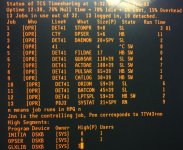m_thompson
Veteran Member
In honor of DEC-20 day I just booted TOPS-10 7.03 on the RICM's DECSYSTEM 2020 #4224. The system was originally installed at the University of Massachusetts, Dartmouth (formerly Southeastern Massachusetts University). It currently has a RP06 disk modified to run on 2-phase 110/220VAC power, an RM03, and two TU45 tape drives.
http://www.ricomputermuseum.org/Home/equipment/dec-pdp-10-decsystem-2020-4224

http://www.ricomputermuseum.org/Home/equipment/dec-pdp-10-decsystem-2020-4224

